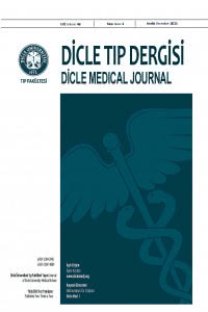Comparison of ventricular repolarization parameters including Tp-e, Tp-e/QTc, JTc and JTd during low-flow and high-flow desflurane anesthesia in gynecologic laparoscopic surgery
Jinekolojik Laparoskopik Cerrahide Düşük ve Yüksek Akımlı Desfluran Anestezisinin Tp-e,Tpe/QTc, JTc ve JTd gibi ventriküler repolarizasyon parametrelerine etkisinin karşılaştırılması
___
1.Johansson A, Lundberg D, Luttropp HH. Low-flowanaesthesia with desflurane: Kinetics during clinicalprocedures. Eur J Anaesthesiol. 2001; 18: 499-504.2.Soyalp C, Dostbil A, Çelik M, et al. The effects ofdesflurane and remifentanyl anaesthesia comparedto lumbar epidural analgesia combined withdesflurane on recovery. Dicle Med J 2014; 41: 640-6.
3.Chugh SS, Reinier K, Singh T, et al. Determinants of prolonged QT interval and their contribution tosudden death risk in coronary artery disease.Circulation 2009; 119: 663–70.
4.Panikkath R, Reinier K, Uy-Evanado A, et al.Prolonged Tpeak to tend interval on the restingelectrocardiogram is associated with increased riskof sudden cardiac death. Circ ArrhythmElectrophysiol 2011; 4: 441–7.
5.Crow RS, Hannan PJ, Folsom AR. Prognosticsignificance of corrected QT and corrected JTinterval for incident coronary heart disease in ageneral population sample stratified by presence orabsence of wide QRS complex: the ARIC study with13 years of follow-up. Circulation 2003; 108: 1985–9.
6.Yildirim H, Adanir T, Atay A, Katircioglu K, SavaciS.The effects of sevoflurane, isoflurane anddesflurane on QT interval of the ECG. Eur JAnaesthesiol 2004; 21: 566–70.
7.Altunbas G, Sucu M, Zengin O. Ventricularrepolarization disturbances after high doseintravenous methylprednisolone Theraphy. JElectrocardiol. 2018 Jan-Feb; 51: 140-4.
8.Silay E, Kati I, Tekin M, et al. Comparison of theeffects of desflurane and sevoflurane on the QTcinterval and QT dispersion. Acta Cardiol. 2005 Oct;60: 459-64.
9.Pirbudak Cocelli L, Ugur MG, Karadasli H.Comparison of effects of low-flow sevoflurane anddesflurane anesthesia on neutrophil and T-cellpopulations. Curr Ther Res Clin Exp. 2012; 73: 41-51.doi:10.1016/j.curtheres.2012.02.005
10.Foregger R. The regeneration of soda limefollowing absorption of carbondioxide.Anesthesiology 1948; 9: 15–20.
11. Branson RD, Campbell RS, Davis K, Porembka DT. Anaesthesia circuits, humidity output, andmucociliary structure and function. AnaesthIntensive Care.
12.Yilmaz Coşkun F, Elboğa G, Altunbaş G, et al.Evaluation of ventricular repolarization featureswith Tp-e, Tp-e/QTc, JTc and JTd duringelectroconvulsive therapy. J Electrocardiol. 2018;51: 440-2.
13.Staikou C, Stamelos M, Stavroulakis E. Impact ofanaesthetic drugs and adjuvants on ECG markers oftorsadogenicity. Br J Anaesth. 2014; 112: 217-30.
14.Weiskopf RB, Moore MA, Eger EI 2nd, et al. Rapidincrease in desflurane concentration is associatedwith greater transient cardiovascular stimulationthan with rapid increase in isoflurane concentrationin humans. Anesthesiology. 1994 May; 80: 1035-45.
15.Ebert TJ., Muzi M. Sympathetic hyperactivityduring desflurane anesthesia in healthy volunteers.A comparison with isoflurane. Anesthesiology.1993; 79: 444–53.
16.Stewart GM, Kavanagh JJ, Koerbin G, SimmondsMJ, Sabapathy S. Cardiac electrical conduction,autonomic activity and biomarker release duringrecovery from prolonged strenuous exercise intrained male cyclists. Eur J Appl Physiol. 2014; 114:1-10.
17. Paksoy F, Ulaş T, Bes C, Dal MS, Borlu F. Corrected Qt interval in patients with metabolic syndrome.Dicle Med J 2011; 38: 274-7.
18.Tadros R, Ton AT, Fiset C, Nattel S. Sexdifferences in cardiac electrophysiology and clinicalarrhythmias: epidemiology, therapeutics, andmechanisms. Can J Cardiol. 2014; 30: 783-92.
19.Kuenszberg E, Loeckinger A, Kleinsasser A, et al.Sevoflurane, but not propofol, significantly prolongsthe Q-T interval. Anesth Analg. 2000 Jan; 90: 25-7.
20.Liu Y, Fu X, Gao H, et al. Effects of differentconcentrations of desflurane on the index of cardiacelectrophysiological balance in gynecologic surgerypatients. Can J Physiol Pharmacol. 2020 May; 98:332-335.
21.Aypar E, Karagoz AH, Ozer S, Celiker A, Ocal T.The effects of sevoflurane and desflurane anesthesia on QTc interval and cardiac rhythm in children.PaediatrAnaesth 2007; 17: 563–7.
22.Cafiero T, Di Minno RM, Di Iorio C. QT intervaland QT dispersion during the induction ofanesthesia and tracheal intubation: a comparison ofremifentanil and fentanyl. Minerva Anestesiol 2011;77: 160–5.
23.Chang DJ, Kweon TD, Nam SB, et al. Effects offentanyl pretreatment on the QTc interval duringpropofol induction. Anaesthesia. 2008 Oct; 63:1056-60.
24.Michaloudis DG, Kanakoudis FS, Petrou AM,Konstantinidou AS, Pollard BJ. The effects ofmidazolam or propofol followed by suxamethoniumon the QT interval in humans. Eur J Anaesthesiol1996; 13: 364–8.
25.Kleinsasser A, Lindner KH, Puehringer F,Hoermann C. Sevoflurane progressively prolongs the QT interval in unpremedicated female adults. Eur J Anaesthesiol 2000; 17: 662–4.
26.Han DW, Park K, Jang SB, Kern SE. Modeling theeffect of sevoflurane on corrected QT prolongation:a pharmacodynamic analysis. Anesthesiology 2010;113: 806–11.
27.Higashijima U, Terao Y, Ichinomiya T, et al. Acomparison of the effect on QT interval betweenthiamylal and propofol during anaestheticinduction. Anaesthesia 2010; 65: 679–83.
28.Kleinsasser A, Loeckinger A, Lindner KH, et al.Reversing sevoflurane-associated QTc prolongationby changing to propofol. Anaesthesia 2001; 56: 248–50.
29.Kazanci D, Unver S, Karadeniz U, et al. Acomparison of the effects of desflurane, sevofluraneand propofol on QT, QTc, and P dispersion on ECG.Ann Card Anaesth. 2009 Jul-Dec; 12: 107-12.
30.Langbein T, Sonntag H, Trapp D, et al. Volatileanaesthetics and the atmosphere: atmosphericlifetimes and atmospheric effects of halothane,enflurane, isoflurane, desflurane and sevoflurane. Br J Anaesth. 1999 Jan; 82: 66-73.
- ISSN: 1300-2945
- Yayın Aralığı: 4
- Başlangıç: 1963
- Yayıncı: Cahfer GÜLOĞLU
Pandemi Döneminde COVID-19 Kliniği ile Başvuran ve Tesadüfen Tespit Edilen AIDS Olgusu
Fethiye AKGUL, Mustafa Kemal ÇELEN
Turner Sendromlu Olguların Değerlendirilmesi
Edip ÜNAL, Yusuf Kenan HASPOLAT
Unal OZTURK, Önder ÖZTÜRK, Şebnem NERGİZ, Yusuf TAMAM, Sefer VAROL
Neoadjuvan Kemoterapi Alan Lokal İleri Mide Kanserli Hastalarda Primer Tümör Lokalizasyonunun Önemi
Gökhan UÇAR, Tülay EREN, Yakup ERGÜN, Ozan YAZICI, Doğan UNCU, Mustafa Özdemir, Erdal BOSTANCI, NURİYE ÖZDEMİR
Seçkin DERELİ, Nurtaç ÖZER, Yasemin KAYA, Ahmet KAYA, OSMAN BEKTAŞ, Mustafa YENERÇAĞ, Mehmet FİLİZ, Fatih AKKAYA
Anticoagulant And Antiplatelet Medication Awareness Of Preoperative Patients
Meltem İNAL, Özge KURUMUŞ, Sedef Gülçin URAL, Hatice TOLUNAY
Ali YILMAZ, Mehmet BİLİCİ, Salim Başol TEKİN
The Spectrum of β-Thalassemia Mutations in Batman, South-Eastern Turkey
